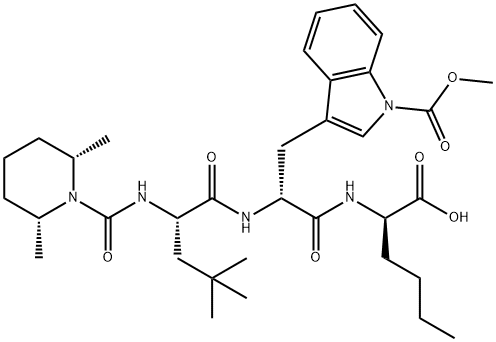173326-37-9
 173326-37-9 結(jié)構(gòu)式
173326-37-9 結(jié)構(gòu)式
基本信息
N-cis-2,6-DiMethylpiperidinocarbonyl-b-tBu-Ala-D-Trp(1-Methoxycarbonyl)-D-Nle-OH
D-Norleucine, N-[(cis-2,6-dimethyl-1-piperidinyl)carbonyl]-4-methyl-L-leucyl-1-(methoxycarbonyl)-D-tryptophyl- (9CI)
D-Norleucine,N-[N-[N-[(2,6-dimethyl-1-piperidinyl)carbonyl]-4-methyl-L-leucyl]-1-(methoxycarbonyl)-D-tryptophyl]-,cis-
(2R)-2-[[(2R)-2-[[(2S)-2-[[(2R,6S)-2,6-dimethylpiperidine-1-carbonyl]amino]-4,4-dimethylpentanoyl]amino]-3-(1-methoxycarbonylindol-3-yl)propanoyl]amino]hexanoicacid
(2R)-2-[[(2R)-2-AMINO-3-(1-METHOXYCARBONYLINDOL-3-YL)PROPANOYL]-[(2S)-2-[[(2R,6S)-2,6-DIMETHYLPIPERIDINE-1-CARBONYL]AMINO]-4,4-DIMETHYLPENTANOYL]AMINO]HEXANOIC ACID
物理化學(xué)性質(zhì)
常見(jiàn)問(wèn)題列表
IC50: 1.2 nM (ETB)
BQ-788 potently and competitively inhibits 125 I-labeled ET-1 binding to ETB receptors in human Girrardi heart cells (hGH) with an IC 50 of 1.2 nM, but only poorly inhibits the binding to ETA receptors in human neuro-blastoma cell line SK-N-MC cells (IC 50 , 1300 nM). BQ-788 shows no agonistic activity up to 10 μM and competitively inhibits thevasoconstriction induced by an ETB-selective agonist (pA2, 8.4). BQ-788 also inhibits several bioactivities of ET-1, such as bronchoconstriction, cell proliferation, and clearance of perfused ET-1.
BQ-788 (3 mg/kg/h, i.v.) completely inhibits a pharmacological dose of ET-1- or sarafotoxin6c (0.5 nmol/kg, i.v.)-induced ETB receptor-mediated depressor, but not pressor responses in conscious rats. Furthermore, BQ-788 markedly increases the plasma concentration of ET-1, which is considered an index of potential ETB receptor blockade in vivo. In Dahl salt-sensitive hypertensive (DS) rats, BQ-788 (3 mg/kg/h, i.v.) increases blood pressure by about 20 mm Hg. It is reported that BQ-788 also inhibits ET-1-induced bronchoconstriction, tumor growth and lipopolysaccharide-induced organfailure. BQ 788 (3 mg/kg) results in an eightfold leftward shift in the ET-1 dose-response curve, suggesting a significant involvement of ETB dilator receptors. Mice are treated with 30?nmol BQ-788 by intraplantar, reduce mechanical hyperalgesia (47% and 42%), thermal hyperalgesia (68% and 76%), oedema (50% and 30%); myeloperoxidase activity (64% and 32%), and overt-pain like behaviours. Additionally, intraplantar treatment with clazosentan or BQ-788 decreases spinal (45% and 41%) and peripheral (47% and 47%) superoxide anion production as well as spinal (47% and 47%) and peripheral (33% and 54%) lipid peroxidation, respectively.